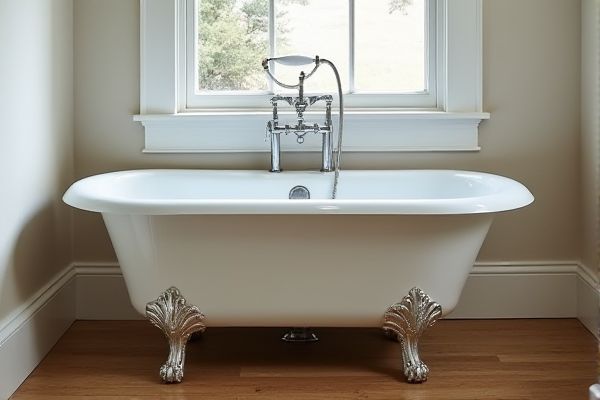
Clawfoot tubs offer a classic, vintage appeal with their four ornately designed feet, while slipper tubs provide an ergonomic design with one end higher for comfortable back support. Explore this article to help you decide which tub style best suits Your bathroom's aesthetic and comfort needs.
Table of Comparison
| Feature | Clawfoot Tub | Slipper Tub |
|---|---|---|
| Design | Four clawed feet, classic Victorian style | Raised backrest, elongated on one side |
| Comfort | Standard back support | Enhanced ergonomic support with sloped back |
| Material | Cast iron or acrylic common | Cast iron or acrylic common |
| Installation | Freestanding, requires floor support | Freestanding, requires floor support |
| Size | Varies, often standard oval shape | Often longer with asymmetrical shape |
| Price Range | $$ to $$$ depending on material and brand | $$$ to $$$$ due to design and size |
| Style Appeal | Vintage, traditional bathroom aesthetic | Elegant, luxury bathroom feel |
Introduction to Clawfoot and Slipper Tubs
Clawfoot tubs feature four ornate, claw-shaped feet that elevate the tub, offering a classic Victorian aesthetic and deep soaking experience. Slipper tubs are characterized by a high, sloped backrest designed to provide ergonomic comfort and support while reclining. Both tub styles are freestanding and essential choices in vintage bathroom designs, blending functionality with timeless elegance.
Design and Style Differences
Clawfoot tubs feature a classic vintage design with four distinct feet that elevate the tub, creating an open and airy feel ideal for traditional bathroom styles. Slipper tubs showcase an elegant asymmetrical shape with one raised backrest, offering enhanced comfort and a distinct, graceful silhouette suited for both modern and antique-inspired interiors. Your choice between these styles depends on whether you prioritize timeless charm or ergonomic luxury in your bathroom design.
Comfort and Ergonomics
Clawfoot tubs offer deep soaking capacity with spacious interiors, promoting full-body immersion and a traditional bathing experience. Slipper tubs feature an elevated backrest designed to support the neck and shoulders, enhancing ergonomic comfort for prolonged relaxation. Both styles provide distinctive comfort benefits, with clawfoot tubs emphasizing depth and slipper tubs prioritizing back support.
Installation Requirements
Clawfoot tubs require freestanding installation with ample floor support due to their heavy cast iron construction, while slipper tubs often need wall adjacency for proper mounting and plumbing connections. Both types demand waterproof flooring and accessible drainage, but clawfoot tubs typically allow for easier repositioning within a bathroom. Plumbing adjustments may vary, with clawfoot tubs accommodating exposed plumbing options, whereas slipper tubs usually conceal pipes behind walls.
Space and Size Considerations
Clawfoot tubs typically have a more classic, rounded design and tend to require more floor space due to their four-legged base, making them suitable for larger bathrooms. Slipper tubs feature an elevated backrest for comfortable lounging, often resulting in a more elongated shape that fits well in narrower spaces without sacrificing relaxation. When choosing between the two, consider your bathroom's dimensions and layout to ensure the tub complements the available space while meeting ergonomic needs.
Material and Durability Comparison
Clawfoot tubs are commonly made from cast iron with a porcelain enamel coating, offering exceptional durability and resistance to chipping or cracking over time. Slipper tubs, often crafted from acrylic or fiberglass, provide a lightweight option but may be more prone to scratches and less resistant to heat compared to cast iron. Your choice depends on whether you prioritize the long-lasting strength and classic feel of cast iron or the modern lightweight convenience of acrylic materials.
Cost and Value
Clawfoot tubs generally range from $1,000 to $4,000 depending on size, material, and finish, offering a vintage aesthetic with durable cast iron construction that adds long-term value. Slipper tubs, often priced between $1,200 and $3,500, provide ergonomic comfort and a modern design but typically use lighter materials like acrylic, which may affect durability and resale value. Choosing between the two depends on balancing initial cost with desired style, comfort, and potential impact on home value.
Cleaning and Maintenance
Clawfoot tubs feature exposed feet that can collect dust and require regular wiping to prevent grime buildup, while slipper tubs have a smooth, elevated design that allows easier access for cleaning around the base. Both types benefit from non-abrasive cleaners to maintain their porcelain or acrylic surfaces without damage. Your choice should consider maintenance preferences, as clawfoot tubs may demand more frequent attention to detail for keeping the decorative feet pristine.
Aesthetic Appeal in Modern Bathrooms
Clawfoot tubs bring a vintage charm with their classic raised feet and rounded edges, creating a striking focal point in modern bathroom designs. Slipper tubs offer a sleek, asymmetrical silhouette with one end elevated for back support, blending old-world elegance with contemporary style. Both styles enhance the aesthetic appeal by combining functionality and timeless design, making them popular choices for luxury spa-like bathrooms.
Which Tub is Right for You?
Clawfoot tubs offer a classic, freestanding design with four elevated feet, providing a timeless aesthetic and deep soaking experience ideal for traditional bathroom styles. Slipper tubs feature an extended backrest that supports a reclined position, delivering enhanced comfort and ergonomic support, perfect for those prioritizing relaxation. Choosing between clawfoot and slipper tubs depends on whether you value vintage charm and versatility or ergonomic design and comfort for long, soothing baths.
 homyna.com
homyna.com